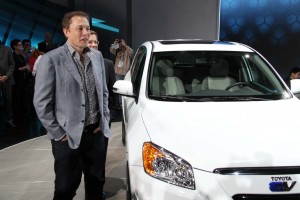The Grinch is back, and this year he’s taking aim at Tesla, the California-based electric vehicle start-up that has seen its shares dip by nearly 25% from where they were trading just a week ago. But that leaves company officials – and industry analysts – wondering exactly what is behind Tesla’s sudden plunge.
While some observers suggest investors may be questioning the firm’s long-term prospects now that mainstream makers like General Motors and Nissan are pushing into “electrification,” others feel the plunge may be more the result of market speculation than anything to do with Tesla’s technology, partnerships, sales or future products.
The 180-day lock up period on sales of Tesla stock will expire on January 29 and traders appear to have zeroed in on the prospects that Tesla’s share will lose value next month because of rising sales pressure. The lock-up period restricts sales of stock acquired on the day Tesla went public last June.
Thus, traders were buying puts – the right to sell shares at a specified price on a specified day — speculating that Tesla’s share will be selling for less than $25 or $26 per share when the six-month lock-up expires. Tesla closed Monday at $25.55.
It doesn’t help the company’s shareholders that Elon Musk, Telsa’s chief executive, faces some serious personal financial challenges and is widely expected to be among the sellers next month.
However, the value of some of Musk’s investments appear to have gained value earlier this month with the successful test of the Dragon space capsule, which was designed by SpaceX, Musk’s private space exploration company. The Dragon is in line to handle the re-supply of the International Space Station once the US space shuttle program is grounded next year.
“At $1.60 each, the $25 puts start to turn a profit once Tesla’s stock price falls below $23.40. The $26 puts, priced at $2.10 apiece, start to become profitable if the company’s shares slip below $23.90,” according to the Wall Street Journal, which also noted that speculation on stock issues nearing the expiration of the 180-day period are not unusual.
While Tesla may be slipping during the waning days of 2010, the stock is still well ahead for those who were able to get in on the IPO, which debuted at $17 a share. The market quickly drove that to $23.89 to end the first day of trading. Tesla peaked at $36.42 late last month.
The automaker has become something of an icon for the emerging electric vehicle market. It has sold several thousand of its 2-seat Roadster sports cars, but the launch of the Tesla Model S sedan has been pushed into 2012, at the earliest. The success of that model will be critical to Tesla’s long-term viability.
But the Silicon Valley-based maker has been developing alternative prospects. It recently announced a partnership with Toyota, with whom it will develop a battery-electric version of the Japanese maker’s RAV4 crossover-utility vehicle. Tesla is also working with Germany’s Daimler AG on a variety of products for the Mercedes-Benz and Smart brands.

